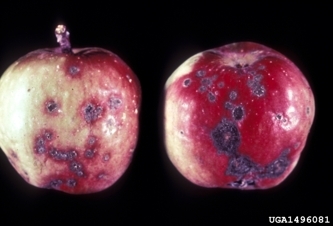
Apple Scab
At least 30 different insects, mites and diseases commonly attack apple trees in Connecticut. Unfortunately, they are not all present at the same time but appear in a definite sequence from the time buds break dormancy until the fruit is ready to be harvested. Therefore, it is not possible to apply two or three sprays and expect to harvest insect and disease-free fruit. If the insect, mite and disease recommendations given in this article are followed carefully, you should obtain a high percentage of clean fruit from a home planting. The proper timing of spray applications and thorough coverage of leaves and fruit are as important as the spray materials used. Be sure to cover all surfaces of the tree. Apply until the spray starts to drip from the foliage.
| Growth Stage | Pests | Remarks |
| Green Tip: when green tissue first shows from buds. | Red mite eggs and scale insects. |
Superior Oil (60-70 sec. vis.) (Read the precautions on label.) |
| Half-Inch Green: when half-an-inch of green tissue projects from the buds. | Scab and rosy aphids | See Apple Scab. |
| Tight Cluster: about seven days after Half-inch Green when blossom buds appear in a tight cluster. Center bud may show some pink color. |
Scab, rusts, black rot, powdery mildew, rosy aphid, leafroller, and caterpillars. |
Fungicide, spray weekly until petal fall. See Apple Rust Disease. |
| Pink: when blossom buds separate from the cluster and all show a pink color but before blossoms open. | Same as above plus red mites. | Add a miticide where needed especially if oil was not used in Green Tip. See Spider Mites. |
| Bloom: when 10% or more of the blossom buds are in bloom. | Scab, rusts, black rot, and powdery mildew. | Do not use any insecticides during the bloom period to protect the pollinators. |
| Petal Fall: when 90% or more of the blossoms have fallen. Sprays applied sooner may kill pollinating insects. | Same as above plus curculio, codling moth leafrollers, and codling moth. | Apply insecticides at the beginning of warm weather (70ºF or above). |
| First Cover: about one week after Petal Fall. |
Same as above except for sawfly. | Add a miticide where needed. |
| Second Cover: about one week after First Cover. | Same as above plus apple aphid. | Rust fungicide no longer needed. |
| Third Cover: about two weeks after Second Cover, mid-to-late June. |
Scab, fruit rots and spots, Apple aphids, curculio, codling moth, and mites. | Add a miticide where needed. |
| Fourth to Eight Covers: apply when needed until early September. | Scab, fruit rots and spots. Apple maggot, aphids, mites, leafrollers, and codling moth. | See Apple Maggot and Its Control for information on controlling this insect without insecticides. |
Despite good cultural practices, pests and diseases at times may appear. Chemical control should be used only after all other methods have failed. For pesticide information please call UConn Home and Garden Education Center or your local cooperative extension office.
The UConn Home & Garden Education Center supports UConn Extension’s mission by providing answers you can trust with research-based information and resources. For gardening questions, contact us toll-free at (877) 486-6271, visit our website at homegarden.cahnr.uconn.edu, or reach out to your local UConn Extension center at cahnr.uconn.edu/extension/locations.
Revised by the UConn Home and Garden Education Center 2019